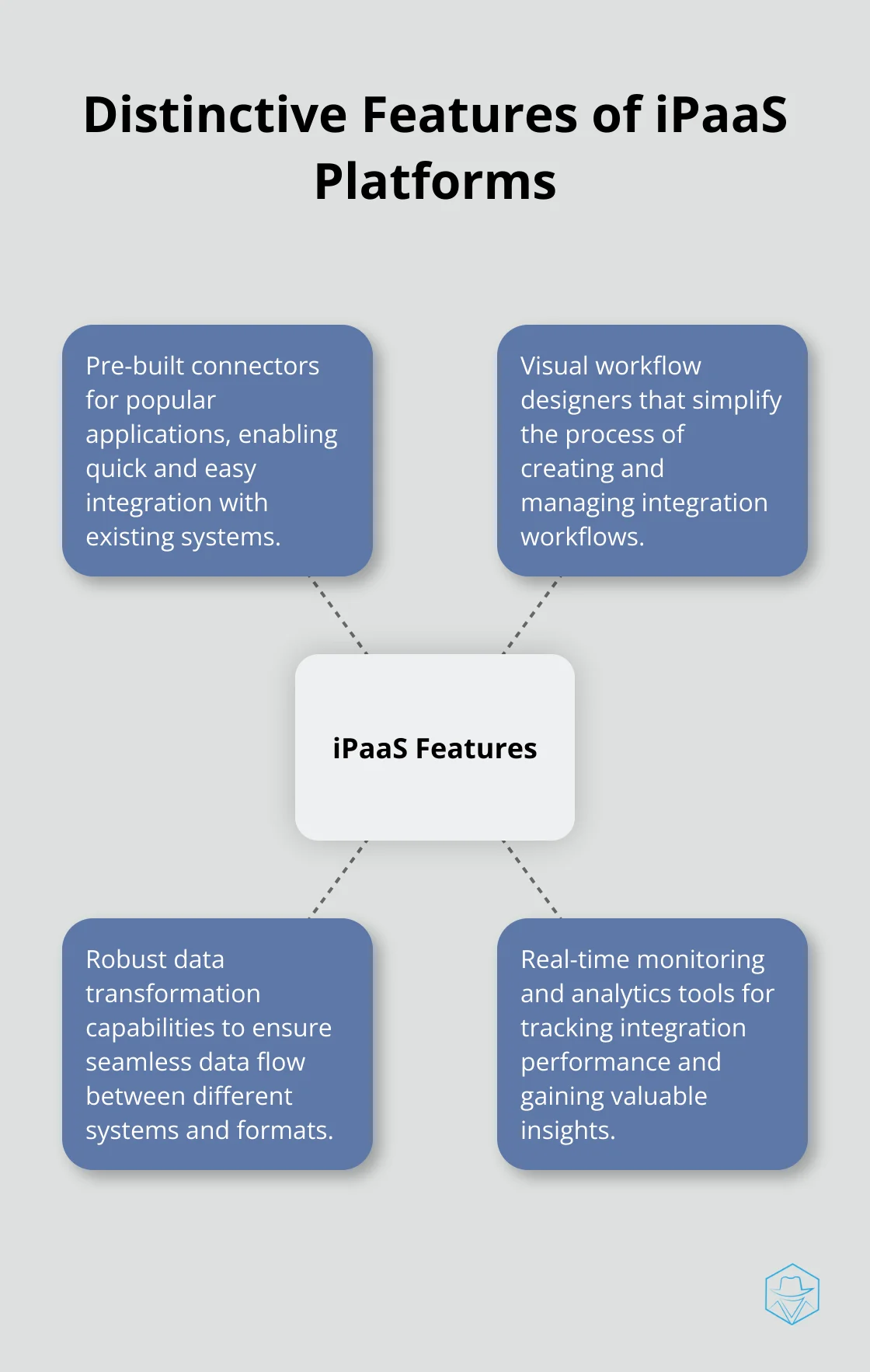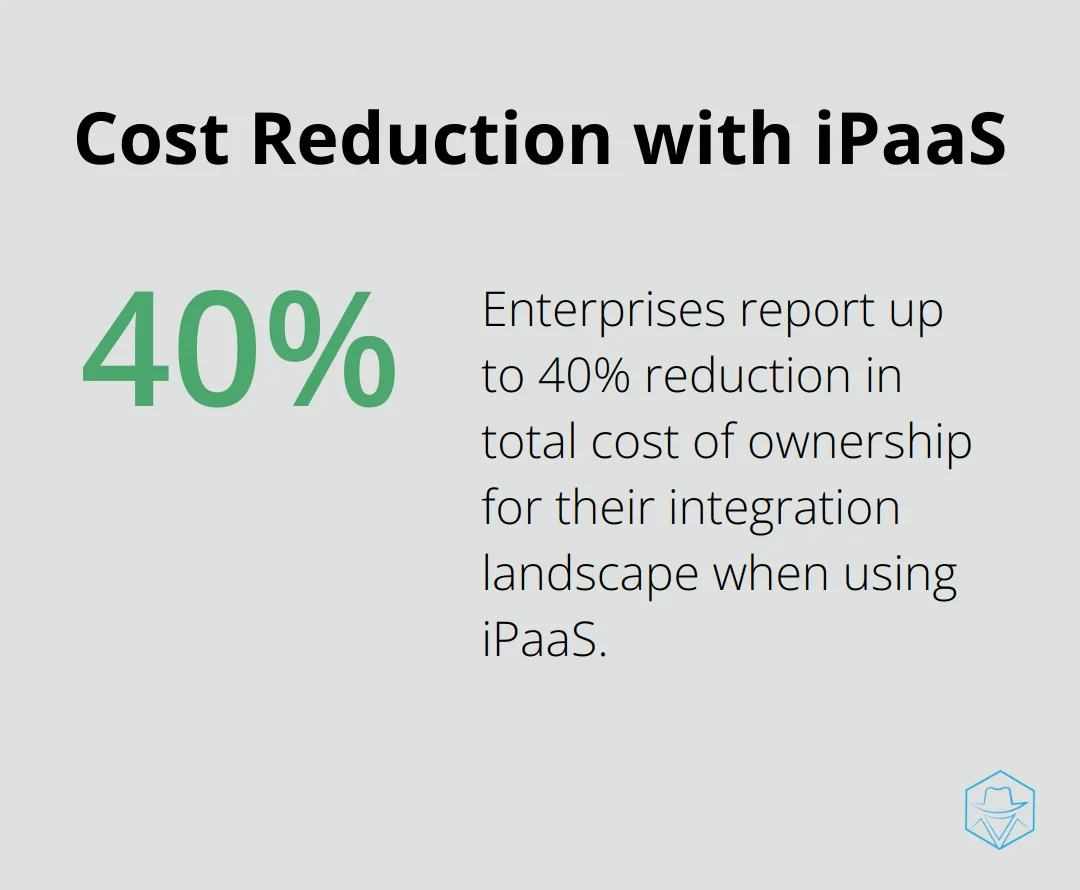How iPaaS Benefits Modern Enterprises

In today’s fast-paced business landscape, enterprises are constantly seeking ways to streamline their operations and boost efficiency. At Drop Cowboy, we’ve seen firsthand how Integration Platform as a Service (iPaaS) has revolutionized the way companies manage their data and applications.
The benefits of iPaaS for modern enterprises are numerous, ranging from improved scalability to enhanced security. This powerful technology is reshaping the future of enterprise integration, and it’s time for businesses to take notice.
What Is iPaaS and Why Does It Matter?
The Core of iPaaS Technology
Integration Platform as a Service (iPaaS) has transformed enterprise integration. This cloud-based platform connects various applications, data sources, and systems seamlessly. iPaaS offers a flexible and scalable alternative to traditional methods, revolutionizing how businesses tackle integration challenges.
From Traditional to Cloud-Based Integration
Traditional integration methods relied on complex, on-premises middleware solutions. These systems required significant IT resources and expertise. They were often rigid, time-consuming to implement, and difficult to maintain. iPaaS, however, simplifies the integration process through its cloud-based approach. This allows businesses to connect their applications and data sources quickly and efficiently.
Distinctive Features of iPaaS
iPaaS platforms stand out with their unique features:
- Pre-built connectors for popular applications
- Visual workflow designers
- Robust data transformation capabilities
- Real-time monitoring and analytics
These features enable businesses to gain valuable insights into their integration processes and identify areas for improvement.

The Competitive iPaaS Landscape
The iPaaS market has experienced significant growth, with numerous providers competing for market share. Leading players include MuleSoft, Dell Boomi, and Informatica. However, Drop Cowboy has positioned itself as a top choice for businesses aiming to enhance their communication and marketing efforts through seamless integration.
Real-World Applications of iPaaS
iPaaS solutions have found applications across various industries and business functions:
- E-commerce: iPaaS integrates order management systems with inventory databases and shipping providers, streamlining the entire order fulfillment process.
- Healthcare: iPaaS facilitates secure exchange of patient data between different healthcare providers and systems, improving care coordination and patient outcomes.
The Evolution of Enterprise Integration
As businesses continue to adopt cloud-based technologies and manage increasingly complex data environments, iPaaS will play a growing role in enterprise integration. The trend points towards more intelligent and autonomous integration platforms. These platforms will incorporate AI and machine learning capabilities to automate complex integration tasks and provide predictive insights.
This evolution of iPaaS technology will continue to reshape how businesses approach integration challenges, paving the way for more efficient and effective data management strategies. The next section will explore the specific benefits that iPaaS brings to modern enterprises, highlighting why this technology has become indispensable in today’s digital landscape.
Why iPaaS Is a Game-Changer for Enterprises
Seamless Data Integration Across Platforms
iPaaS eliminates data silos by connecting disparate systems and applications. This integration allows for real-time data synchronization, ensuring that all departments have access to up-to-date information. A study by Forrester Research found that companies using iPaaS solutions experienced a 345% return on investment over three years (with a payback period of less than six months).
Unparalleled Scalability
One of the key advantages of iPaaS is its ability to scale effortlessly. As businesses expand, iPaaS accommodates increasing data volumes and integration complexity without requiring significant infrastructure changes. This scalability proves crucial in today’s fast-paced business environment, where agility can determine a company’s success.
Significant Cost Savings
iPaaS substantially reduces integration costs. Enterprises using iPaaS report a reduction in the total cost of ownership of their integration landscape by up to 40%. This cost reduction stems from decreased need for custom coding, lower maintenance requirements, and the elimination of hardware investments associated with traditional integration methods.

Enhanced Collaboration and Productivity
iPaaS facilitates seamless data flow between different departments and applications, which enhances collaboration within organizations. This improved connectivity leads to increased productivity as employees spend less time manually transferring data or switching between applications. A Deloitte study revealed that a lack of job challenge (often caused by repetitive tasks like manual data entry) is a top reason for employee turnover. iPaaS addresses this issue by automating such tasks.
Robust Security and Compliance Management
In an era of increasing data regulations, iPaaS offers strong security features and compliance management tools. Many iPaaS solutions meet important data security and privacy standards such as SOC 2, HIPAA, and GDPR. This compliance fosters confidence among legal teams and clients, ensuring that data integrations adhere to the strictest security protocols.
The benefits of iPaaS extend far beyond these points, reshaping how enterprises approach their data and application management strategies. As we continue to witness advancements in this technology, its role in driving business success will only grow more significant. The next section will explore best practices and considerations for implementing iPaaS in your organization.
How to Implement iPaaS Successfully
Assess Your Integration Landscape
Start with a thorough evaluation of your current integration needs. Identify all systems, applications, and data sources that require connection. Include both on-premises and cloud-based systems in this assessment. Consider future integration requirements as your business expands.
Many organizations underestimate the scope of their integration needs. A survey by MuleSoft revealed that 82% of business technology professionals report backlogs in integration tasks. To avoid this pitfall, involve stakeholders from various departments to ensure identification of all integration points.

Select the Right iPaaS Solution
The choice of an appropriate iPaaS solution is critical for success. Look for platforms that offer pre-built connectors for your existing systems, robust security features, and scalability to accommodate future growth.
Consider factors such as ease of use, support for hybrid environments, and the availability of low-code or no-code tools. These features can significantly reduce implementation time and costs. For instance, some iPaaS solutions combine integration capabilities with automation, allowing for enterprise-grade solutions without coding skills (a feature that sets them apart in the market).
When evaluating vendors, request case studies or references from companies in your industry. This approach provides valuable insights into how the solution performs in real-world scenarios similar to yours.
Plan Your Implementation Strategy
After choosing your iPaaS solution, develop a detailed implementation plan. Begin with a pilot project to test the waters and gain valuable experience. This method allows you to identify and address potential issues before rolling out the solution across the entire organization.
Create a timeline for implementation, including milestones for each phase of the project. Assign clear roles and responsibilities to team members involved in the implementation process. This clarity helps prevent confusion and ensures accountability.
Don’t underestimate the importance of training. Ensure that your team receives comprehensive training on the new iPaaS platform. This investment in education can significantly reduce implementation time and improve adoption rates.
Address Common Challenges
Implementing iPaaS can present several challenges. Data security and compliance often top the list of concerns. Try to choose an iPaaS provider that offers robust security features and complies with relevant industry standards (such as GDPR or HIPAA).
Another common challenge is resistance to change from employees. To address this, communicate the benefits of the new system clearly and provide adequate support during the transition period.
Integration with legacy systems can also pose difficulties. Some iPaaS solutions offer specific tools or connectors for legacy integration (which can be a significant advantage in certain industries).
Final Thoughts
The benefits of iPaaS for modern enterprises extend far beyond streamlined operations. iPaaS transforms how businesses manage data, automate workflows, and connect disparate systems. This technology enables organizations to achieve unprecedented levels of efficiency and agility in the digital age.
The future of iPaaS promises even more exciting developments. Artificial intelligence and machine learning will enhance automation capabilities, while edge computing and IoT integration will revolutionize real-time data processing. These advancements will position iPaaS as an indispensable tool for businesses seeking to stay competitive in an increasingly data-driven world.
Drop Cowboy offers innovative features like ringless voicemail and SMS integration, powered by advanced technologies. Our platform enables businesses to create personalized, engaging campaigns that reach customers effectively across multiple channels. We invite you to explore how iPaaS can benefit your organization and take the first step towards a more connected, efficient, and agile enterprise today.
blog-dropcowboy-com
Related posts

May 27, 2025
Elead CRM: Revolutionizing Automotive Sales Management
Transform automotive sales management with Elead CRM and boost efficiency. Explore cutting-edge tools for dealership success now.

June 27, 2025
Parallel Dialer: Maximize Your Calling Capacity
Boost efficiency with a parallel dialer. Maximize your calling capacity and connect with more leads effortlessly. Discover practical tips and tools here.
![Mastering the Art of Personalized Voicemail Drops [Guide]](/blog/wp-content/uploads/emplibot/personalized-voicemail-drops-hero-1756166794-600x400.webp)
August 28, 2025
Mastering the Art of Personalized Voicemail Drops [Guide]
Learn how to master personalized voicemail drops to boost engagement and enhance your customer interactions with effective strategies and tips.

April 21, 2025
CRM vs Marketing Automation: Which Do You Need?
Compare CRM vs Marketing Automation to boost efficiency. Discover which tool best fits your business needs for growth and better customer management.

August 13, 2025
What does it mean when u call someone and it goes straight to voicemail
Explore what it means when you call someone and it goes straight to voicemail. Understand why it happens and learn effective communication tips.

June 10, 2025
CRM for Property Managers: Simplify Tenant Relations
Boost tenant relations using CRM for property managers. Streamline communication, manage tenant data, and enhance property operations seamlessly.